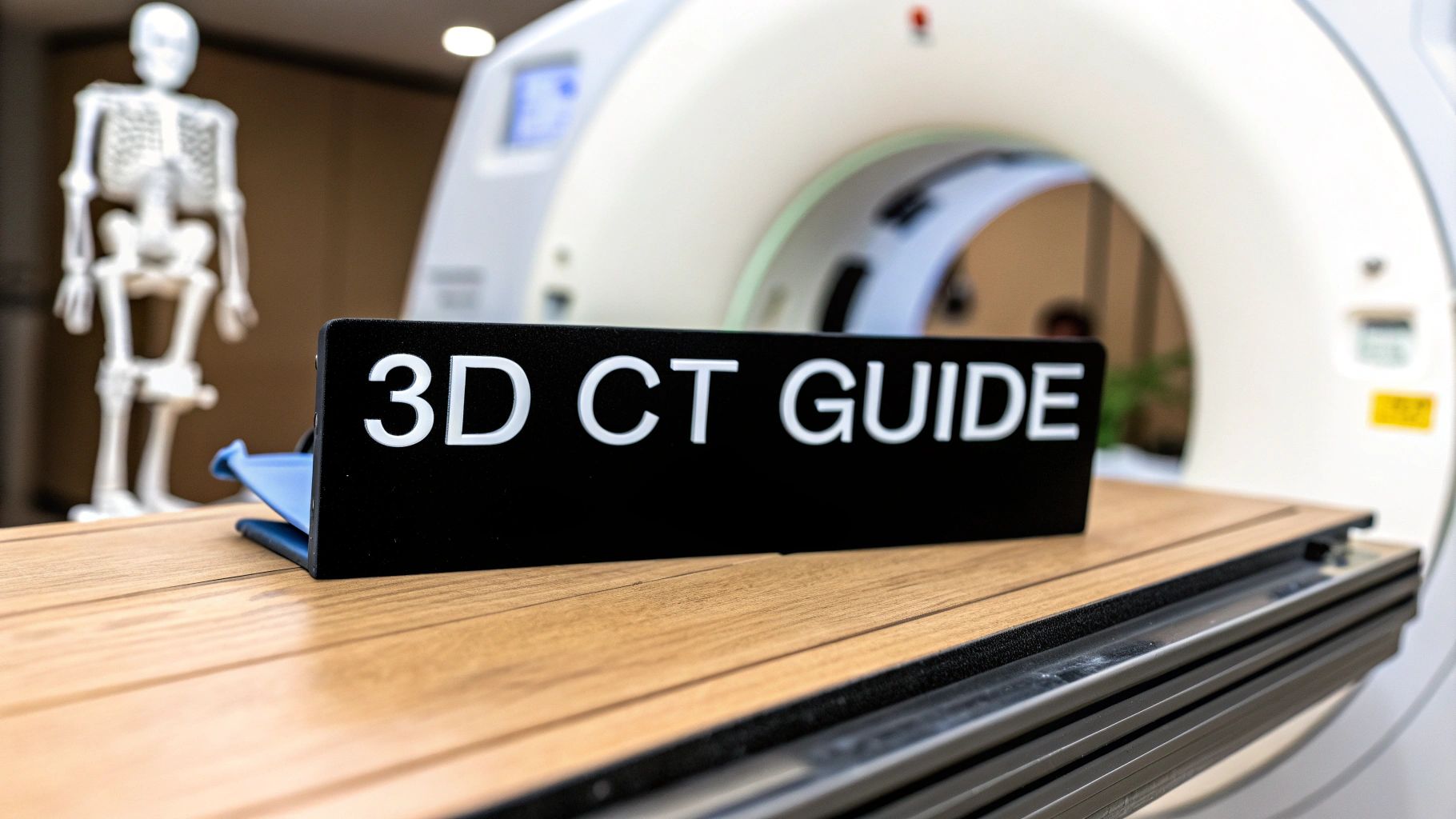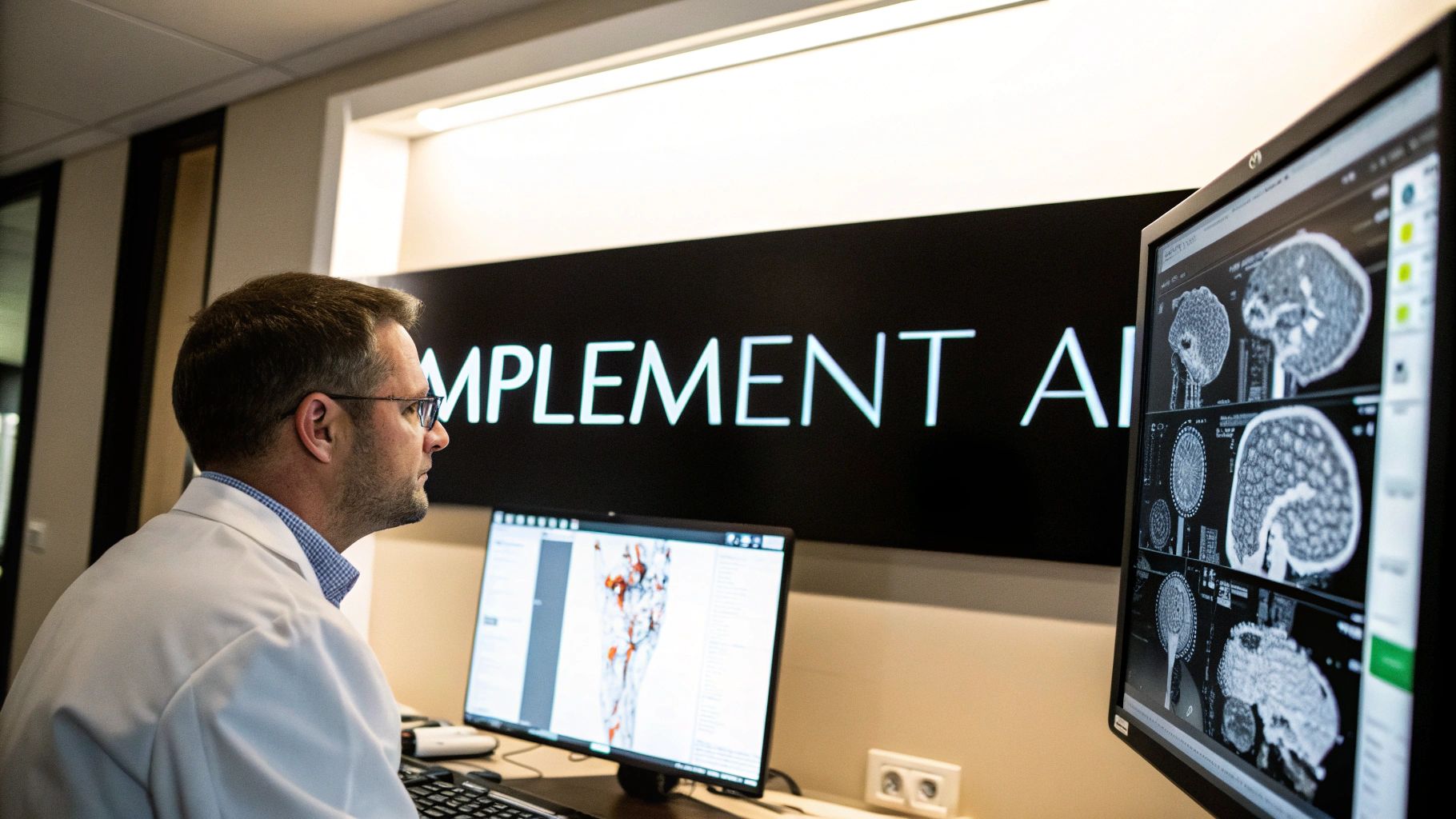Decoding Standardized Uptake Value: What You Need to Know

The standardized uptake value (SUV) is a key measurement in modern medicine, especially for positron emission tomography (PET) scans. This semi-quantitative measurement helps medical professionals evaluate the metabolic activity of tissues. It has become an essential tool, particularly in oncology, for diagnosing and monitoring various conditions.
This value represents the ratio of radiotracer concentration within a specific region of interest (ROI) compared to the expected average concentration throughout the body. Imagine measuring the sugar concentration in a single grape versus the average sugar level in the whole bunch. A higher sugar level in one grape might indicate something unique about that grape.
Similarly, a higher SUV in a tissue area suggests increased metabolic activity. This can be a crucial indicator for various diseases, particularly cancer. Understanding SUV calculation is important for interpreting its meaning. Several factors influence SUV values, including the time elapsed between tracer injection and imaging.
Understanding SUV Calculation
Other factors affecting SUV include the patient's blood glucose level and the specific PET agent used. For example, 18F-FDG PET scans typically involve a uptake period around 94 ± 9 minutes. The SUV is calculated as the ratio of radioactivity concentration in a region of interest to the theoretical whole-body concentration based on the injected dose and patient weight.
This calculation gives a semi-quantitative measure of metabolic activity. However, factors like blood glucose can influence SUV readings, meaning normalization to such factors is sometimes necessary. The Journal of Nuclear Medicine provides more in-depth information about the nuances of SUV. Its use in oncology has become widespread due to its ability to identify areas of high metabolic activity, assisting in the identification and monitoring of tumors.
Different Types of SUV Measurements
Several types of SUV measurements are used in clinical practice. Each offers unique insights into tissue metabolism:
-
SUVmax: This represents the maximum SUV within a defined ROI. It is often used to assess the most metabolically active part of a tumor.
-
SUVmean: This calculates the average SUV across the entire ROI. It provides a broader overview of metabolic activity in the area.
-
SUVpeak: This represents the average SUV within a smaller, fixed-size volume inside the ROI. It provides a more focused measurement.
These different SUV measurements, each with its own strengths and limitations, give clinicians a detailed metabolic profile of the examined tissue. This information plays a critical role in making accurate diagnoses and developing effective treatment plans.
Mastering SUV Calculations: From Numbers to Clinical Insights
As we've discussed, the standardized uptake value (SUV) plays a vital role in interpreting PET scan results. Let's explore the calculations involved in converting raw data into meaningful clinical information. This process allows doctors to understand the data and make informed decisions about patient care.
Understanding the Math Behind SUV
The fundamental formula for SUV uses the radiotracer concentration in the target area, the injected dose, and the patient's weight. This calculation produces a standardized ratio, enabling comparisons between different scans, even those taken on different machines or at different facilities. This standardization is essential for accurate diagnosis and treatment monitoring, ensuring consistency and reliability.
Key SUV Measurements: SUVmax, SUVmean, and SUVpeak
Several types of SUV measurements exist, each with a specific purpose:
-
SUVmax: This measurement identifies the highest SUV within a defined area, similar to finding the highest peak in a mountain range. SUVmax is valuable for locating the most metabolically active area of a tumor.
-
SUVmean: This represents the average SUV across a specific region. It’s like calculating the average height of all the mountains in a range. SUVmean gives a broader overview of the metabolic activity in the area.
-
SUVpeak: This measures the average SUV within a smaller, fixed-size volume inside the region of interest. It's like zeroing in on a particular cluster of peaks within that larger mountain range. SUVpeak refines the measurement by minimizing the influence of background activity.
To better understand these measurements, let's take a look at the following table:
Common SUV Measurement Types and Their Applications
| SUV Type | Definition | Advantages | Limitations | Primary Clinical Applications |
|---|---|---|---|---|
| SUVmax | Maximum SUV within a region | Easy to measure; reflects highest metabolic activity | Sensitive to noise and partial volume effects | Initial tumor assessment, staging |
| SUVmean | Average SUV across a region | Less sensitive to noise; reflects overall metabolic activity | May underestimate focal uptake | Treatment response evaluation, prognosis |
| SUVpeak | Average SUV in a small, fixed volume | Reduces partial volume effects | Requires precise volume definition | Quantifying focal uptake, reducing noise impact |
This table summarizes the key differences between the three SUV measurements, including their definitions, advantages, limitations, and primary uses in clinical practice.
The Importance of Accurate SUV Interpretation
Interpreting SUV values requires careful consideration of various factors. Even small variations in SUV can have significant clinical implications. A change in SUV could, for example, signify a treatment response or disease progression. Therefore, differentiating between normal fluctuations and clinically relevant changes is essential. Standardized protocols and expert analysis are crucial for accurate and dependable SUV interpretation in patient care. Understanding these nuances is paramount for accurate disease diagnosis and management, particularly in cases of cancer.
The Hidden Variables Affecting Your SUV Measurements

While understanding how to calculate standardized uptake values (SUVs) is important, recognizing the factors that can influence these measurements is equally crucial. Many unseen variables can significantly impact the accuracy of SUV results. This means two patients with seemingly identical conditions might have dramatically different SUV readings.
One factor affecting SUV is blood glucose level. Elevated blood glucose can compete with the radiotracer, reducing its uptake in tissues and leading to a lower SUV. This is particularly important for patients with diabetes or other metabolic conditions.
Additionally, the timing of the scan relative to the tracer injection plays a crucial role. Variations in uptake time can directly affect the measured radioactivity concentration and, consequently, the SUV.
For example, some institutions use a standard uptake time of 60 minutes, while others might wait 90 minutes. This seemingly small difference can lead to significant variations in SUV readings.
Patient-Specific Considerations in SUV Interpretation
Even with standardized protocols, inherent patient-specific factors can introduce variability. Body composition, for instance, plays a significant role. Patients with higher body fat percentages might exhibit different tracer distribution patterns compared to leaner individuals. This can impact the calculation of the theoretical whole-body concentration used in the SUV formula.
Furthermore, inflammatory conditions can increase glucose metabolism, potentially elevating SUV values. This elevation might be misinterpreted as increased tumor activity. The standardized uptake value (SUV) is a crucial metric in medical imaging, particularly in positron emission tomography (PET). It's used to assess metabolic activity in tissues, such as tumors. Find more detailed statistics here: Standardized Uptake Value Research
Experienced radiologists consider various patient-specific factors when interpreting SUV results, such as age, sex, and underlying medical conditions that could influence glucose metabolism. Medications can also play a significant role, as some drugs can interfere with radiotracer uptake or alter metabolic rates.
Minimizing Variability and Improving Accuracy
Leading institutions strive to minimize variability in SUV measurements by implementing standardized protocols. These protocols include precise guidelines for patient preparation, including dietary restrictions and blood glucose monitoring. They also specify the timing of the scan and the reconstruction parameters used for image processing. This rigorous approach ensures greater consistency and reliability in SUV measurements.
Additionally, ongoing research focuses on developing more robust SUV correction methods that account for patient-specific variables. These methods aim to further enhance the accuracy and reliability of SUV in clinical practice.
Addressing Potential Misinterpretations
Given the potential for variability and misinterpretation, it's essential to avoid relying solely on SUV for diagnosis. SUVs should always be considered alongside other clinical findings, like patient history, physical examination, and other imaging modalities. This comprehensive approach minimizes the risk of misdiagnosis or inappropriate treatment based on misleading SUV values.
By taking a multifaceted approach to interpretation, clinicians can leverage the power of SUV while mitigating its inherent limitations. This integrated strategy ensures SUV measurements contribute effectively to informed clinical decision-making and better patient outcomes.
SUV in Clinical Practice: Transforming Cancer Care

The standardized uptake value (SUV) is essential in modern cancer care. It has evolved from a simple diagnostic tool to a crucial component in treatment planning, response assessment, and prognostication. By quantifying metabolic activity, SUV provides clinicians with vital insights into tumor behavior, guiding critical decisions throughout the patient's journey.
Distinguishing Benign from Malignant Lesions
One of the primary applications of SUV is differentiating benign and malignant lesions. While CT and MRI scans offer anatomical details, SUV adds a functional layer by highlighting areas with increased metabolic activity. This is particularly valuable when anatomical features alone are inconclusive.
For instance, a suspicious lung nodule on a CT scan can be further assessed using PET imaging and SUV measurements. A high SUV might indicate malignancy, suggesting the need for a biopsy. Conversely, a low SUV could suggest a benign process, potentially avoiding an invasive procedure.
Determining Tumor Aggressiveness and Treatment Approach
SUV is also instrumental in determining tumor aggressiveness. Higher SUV values generally correlate with more aggressive tumors—those with higher growth rates and a greater potential for metastasis. This information allows clinicians to tailor treatment strategies more effectively.
A high SUV, indicating an aggressive tumor, might require intensive treatment, like surgery combined with chemotherapy or radiation. A lower SUV, suggesting a less aggressive tumor, might be managed with a less intensive approach.
Monitoring Treatment Response and Disease Progression
SUV values are now routinely used in treatment monitoring. This gives physicians an objective measure of treatment effectiveness, allowing for adjustments based on metabolic changes within the tumor. This can be crucial for determining if a treatment is working even before changes in tumor size become apparent.
A decrease in SUV after chemotherapy suggests a positive response. A stable or increasing SUV may signal treatment resistance, prompting a change in strategy.
SUV and Hodgkin Lymphoma
SUV measurement is particularly relevant in monitoring Hodgkin Lymphoma (HL) treatment. Reductions in SUV from baseline scans are tracked to assess treatment response. Studies show that SUV reductions remain consistent between scans taken at different treatment stages (e.g., after two and four cycles). This consistency is vital for reliable treatment evaluation. SUV in Hodgkin Lymphoma Treatment
SUV is often used with other imaging techniques to provide a complete picture of disease progression. The reproducibility of SUV measurements is critical, as even small variations can significantly impact patient care.
SUV Thresholds in Various Cancers
Different cancers display unique SUV patterns, requiring specific interpretation guidelines. The following table summarizes typical SUV ranges and their clinical implications for several common cancer types.
To better understand how SUV values are interpreted in different cancer types, let's take a look at the following table:
SUV Thresholds and Clinical Significance Across Different Cancer Types: This table presents typical SUV ranges and their clinical interpretations for various common cancer types.
| Cancer Type | Typical SUVmax Range | SUV Threshold for Malignancy Suspicion | Prognostic Implications | Treatment Response Indicators |
|---|---|---|---|---|
| Lung Cancer | 0.0 – >20.0 | >2.5 | Higher SUV often associated with poorer prognosis | Decrease in SUV after therapy suggests response |
| Breast Cancer | 0.0 – >20.0 | Varies depending on subtype and other factors | Higher SUV can indicate more aggressive disease | Decline in SUV during neoadjuvant chemotherapy |
| Colorectal Cancer | 0.0 – >20.0 | >2.5 – 3.0 (varies) | Higher SUV may be linked to advanced stage | Decrease in SUV post-therapy indicates response |
| Lymphoma | 0.0 – >30.0 (wide range) | Varies greatly by subtype | Higher SUV potentially indicative of higher tumor burden | Significant SUV reduction after chemotherapy suggests positive response |
This table provides a general overview, and it's important to note that SUV interpretation should always be considered in conjunction with other clinical findings. The specific thresholds and prognostic implications can vary based on factors such as the imaging equipment, reconstruction method, and patient-specific characteristics.
Ongoing research continues to refine our understanding of SUV's role across various cancers. This leads to more accurate diagnoses, prognoses, and personalized treatment approaches, ultimately improving patient outcomes.
Tracking Treatment Success: How SUV Guides Cancer Therapy
After a cancer diagnosis, the critical question is: is the treatment working? The standardized uptake value (SUV) plays a vital role in answering this, providing objective evidence of treatment effectiveness long before any noticeable physical changes appear. This metabolic measurement gives doctors a glimpse into how the tumor is responding at a cellular level. For additional clinical resources, you may find iClinics helpful.
Understanding PERCIST Criteria
Medical experts have established specific criteria, like PERCIST (PET Response Criteria in Solid Tumors), to measure significant metabolic changes in tumors. PERCIST uses SUV measurements to assess treatment response. These criteria offer a standardized framework for evaluating shifts in tumor metabolism, empowering clinicians to make informed decisions about continuing, adjusting, or changing treatment plans. This objective assessment is essential for guiding personalized cancer therapy.
Baseline and Follow-Up SUV Comparisons
Comparing baseline SUV measurements (taken before treatment starts) with follow-up scans creates a metabolic timeline of the disease's response. This timeline reveals the dynamic changes happening within the tumor, offering insights that anatomical imaging alone cannot provide. By monitoring SUV changes, clinicians gain a deeper understanding of the tumor's behavior and its response to treatment over time.
Interpreting Patterns of SUV Change
Different patterns of SUV change have specific clinical implications. A significant drop in SUV generally indicates a positive response to treatment. This suggests the therapy is effectively targeting the tumor and decreasing its metabolic activity.
However, a stable or rising SUV may signal treatment resistance. This vital information allows oncologists to quickly adapt their strategies, potentially changing to a different treatment plan or considering other therapeutic approaches.
SUV and Tumor Biology
SUV changes can also illuminate the underlying tumor biology and potential mechanisms of treatment resistance. For instance, some tumors may initially exhibit a decrease in SUV followed by a subsequent increase. This pattern could suggest the development of resistance to the current treatment. This knowledge can be invaluable in directing further research and developing more effective therapies tailored to each patient and their unique tumor characteristics.
SUV in Clinical Trials
SUV is regularly used in clinical trials to assess treatment response. This provides researchers with unbiased data to evaluate the effectiveness of new therapies and refine treatment protocols. Understanding how SUV is used in clinical trials offers deeper insights into the broader role of this important metric in advancing cancer care.
The Future of Standardized Uptake Value: Breaking Boundaries

Standardized uptake value (SUV) has become a cornerstone of diagnostic imaging, especially in oncology. Currently, its potential is only beginning to be explored. New technologies and methods offer the promise of overcoming existing limitations and expanding the ways SUV can be used. This means SUV could become an even more crucial tool for diagnosing and managing a variety of diseases. SUV plays a vital role in assessing treatment response during clinical trials. You can learn more about this process in this article on clinical trial data analysis.
Artificial Intelligence and SUV Data
Artificial intelligence (AI) is set to reveal deeper insights from SUV data. AI algorithms can detect subtle patterns within PET scans, patterns that are often imperceptible to the human eye. This capability has the potential to increase diagnostic accuracy and create more personalized treatment strategies.
For example, AI might be able to identify specific SUV patterns that predict how a patient will respond to treatment, or even predict disease progression. This increased precision could lead to earlier and more effective interventions, ultimately improving patient outcomes.
Radiomics: Extracting More from SUV Distributions
Radiomics represents another exciting area that is expanding the power of SUV. This technique transforms SUV distributions within a tumor into quantifiable features, creating a comprehensive metabolic profile.
These features can then be used as predictive biomarkers for a variety of clinical outcomes, including prognosis and response to therapy. This allows radiomics to provide a more comprehensive understanding of a tumor’s behavior, leading to better informed, more effective, and personalized treatment decisions.
Expanding Beyond FDG: New Tracers and Applications
The applications of standardized uptake value extend beyond the 18F-FDG tracer. New PET tracers are continually being developed, broadening the use of SUV to diseases other than cancer.
For example, promising new tracers are targeting specific proteins or receptors and are showing potential in neurological disorders, cardiovascular disease, and infection imaging. This wider application of SUV methodology unlocks new possibilities for early diagnosis and targeted treatments across a broader spectrum of health conditions.
From Research to Clinical Practice: Real-World Impact
The advancements discussed here are more than just theoretical concepts. Many are actively making the transition from research labs into everyday clinical practice, leading to noticeable improvements in patient care. For instance, AI-powered diagnostic tools are beginning to be integrated into hospitals, allowing for earlier and more precise diagnoses. This facilitates quicker intervention and has the potential to dramatically improve patient outcomes.
The Potential for Personalized Medicine
The future of standardized uptake value is deeply intertwined with the rise of personalized medicine. Combining SUV data with other patient-specific factors, such as genetics and lifestyle, allows clinicians to tailor treatments much more effectively. This personalized approach seeks to maximize the effectiveness of therapy while minimizing adverse side effects, leading to better results for patients.
PYCAD is at the forefront of integrating AI into medical imaging. Our AI solutions improve both diagnostic accuracy and operational efficiency, optimizing medical devices and ultimately enhancing patient care. Learn how PYCAD can help revolutionize your medical imaging processes.






